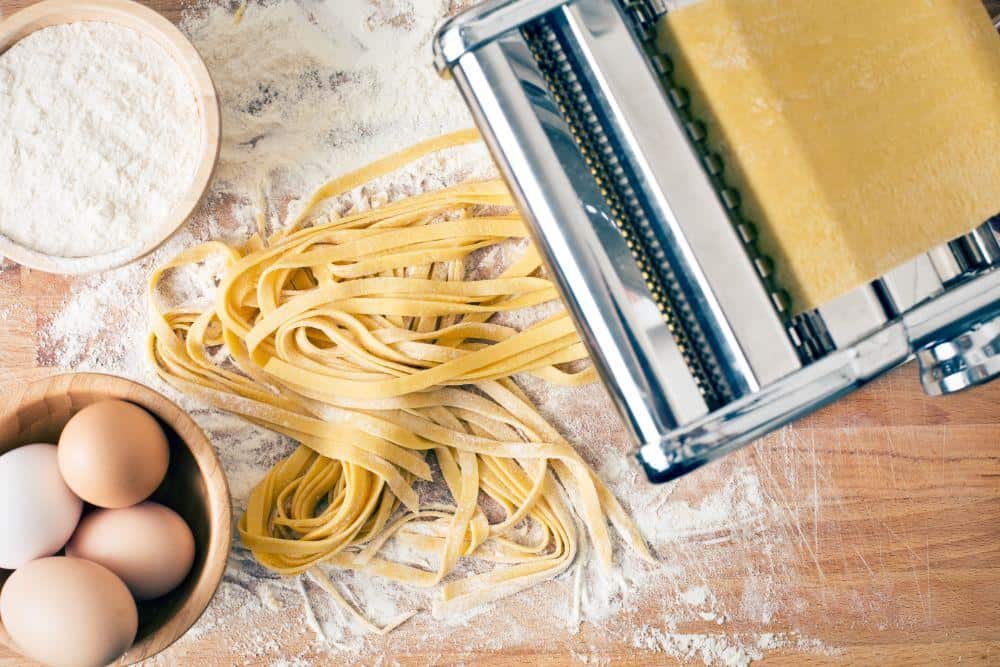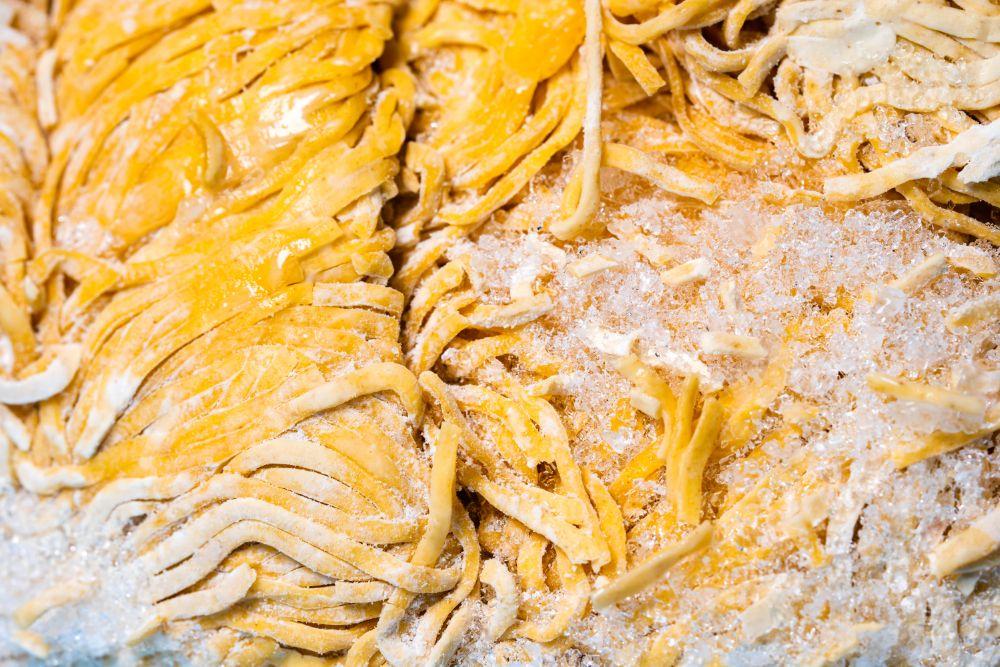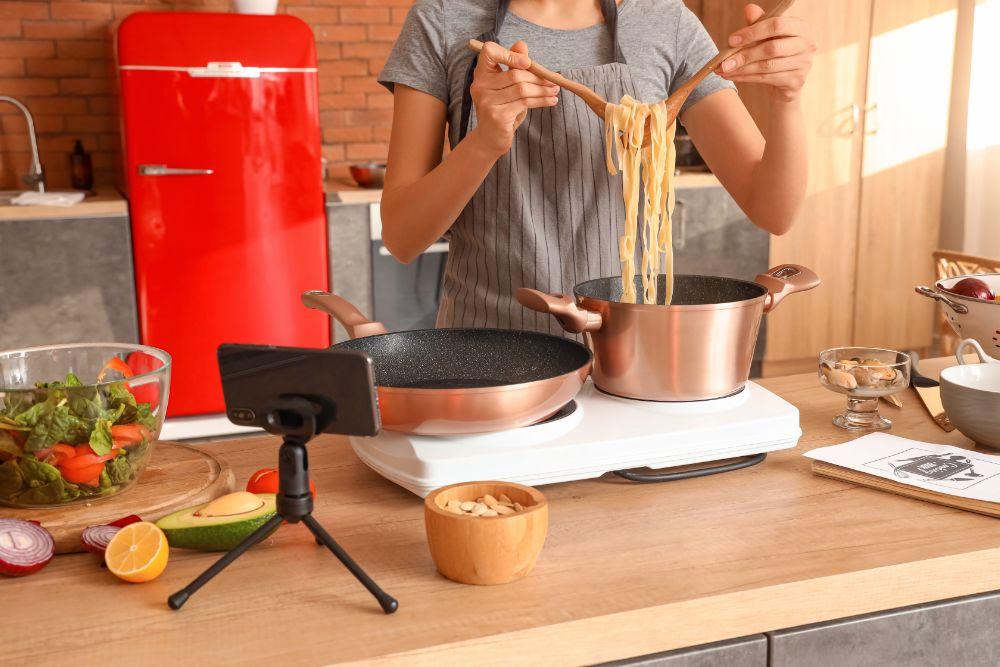Making homemade fresh pasta is a challenge. Even if you follow every step and note in the recipe, things can still go awry. If you want to know what to do if your pasta dough is too dry, this article has some tips to help you.
The best remedy for dry pasta dough is to add a little water and knead it again until the dough is moist and soft.
Keep reading to understand why your pasta dough may be dry, how you can fix it, and other tips for people stepping into the world of homemade pasta.
There are a few common mistakes home cooks make with their pasta dough. Consider if one of the three causes below could be the reason your pasta dough is dry.
The number one reason fresh pasta dough comes out dry is that you used too much flour. Too much flour or semolina flour, like with any dough, will make it crumbly and the gluten in the dough won’t form properly.
When following a fresh pasta recipe, you should always use slightly less flour than it says to start. You can always add more flour to the dough as you knead it, ensuring it has the proper texture.
The lovely thing about making dough is you can tweak the texture easily, adding flour, semolina, or water until you achieve the perfect consistency.
When in doubt about your dry pasta dough, too much flour is almost always the answer, as it's a simple mistake to make even if you measure your flour.

Too Much Flour Might be Why Your Pasta is Too Dry
Over-kneading dough is harder to do than most people think. If the dough ingredients are balanced, you should be able to knead the dough for a long time without issue. However, it is possible to over-knead fresh pasta dough.
But you also don’t want to under-knead the homemade pasta dough, as the gluten may not set, meaning your fresh pasta will be ruined.
Make sure you knead until all ingredients are thoroughly combined, creating a smooth texture and homogenized appearance. If you see specks of flour, you need to keep kneading. The best way to avoid over kneading the dough is to use your hands and consistently assess the texture.
Using a kneading machine can easily lead to the over-kneaded dough if you don’t pay close attention. You can tell the dough is over-kneaded when it becomes difficult or impossible to stretch without breaking.
With any dough, the rising time is crucial to achieving the right texture. Pasta dough typically needs to rest and rise for about 30 minutes before it can be cut into the desired pasta shape and promptly boiled.
But the dough should be kept in a humid location when resting, otherwise, it can dry out before you use a pasta roller to make a pasta sheet. Many home cooks place a damp kitchen cloth over the bowl to keep the dough moist as the gluten forms.
Some people wrap their homemade pasta dough in plastic while it rests. This method is okay, but not excellent, as the wrap can hinder the resting process. But it’s better than leaving the dough exposed to the air, allowing it to release moisture, becoming hard and dry.
If you made beautiful pasta dough and then let it sit on your kitchen counter in the sun for half an hour, this was likely the cause of your dry pasta dough.

Pasta can Become Dry When Exposed to the Air
What to do if your pasta dough is too dry depends on the situation. Not all dry homemade pasta dough can be saved, unfortunately. But there are some tricks you can try to bring the dry dough back to life so you can still make the fettuccine you’ve been looking forward to.
This solution is the simplest and typically the most effective. If you notice your pasta dough is dry, whether as you're kneading or after it’s been resting, you can add more water to moisten it. Depending on how dry the pasta dough is, you have a few options.
If it just needs a little water, wet your hands and then knead the dough again, and the water on your hands will moisten the dough.
You can also use a pasta roller to make the dough into a pasta sheet, spritz some water on either side and allow it to sit for a few minutes.
And lastly, if it’s super dry pasta dough, you can sprinkle a spoonful or two on top of the dough and knead it again. Add as much water as you need to achieve the right texture.
If you add too much water, you can always add more flour or semolina to balance the dough. But either way, it will need to rest again when you’re done.
If the dough seems a little dry after resting for about 30 minutes, allowing it to rest longer can help moisten it. This remedy won’t work if your environment is dry. But if the resting environment for the dough is humid, leaving it to rest longer can help it absorb some moisture.
Wet a clean kitchen towel and place it over the dough, as this can keep it more humid and help it moisten before you roll it out. This remedy isn’t the most effective, but it's worth a try if you don’t want to add more water and start the kneading and resting process all over again.
If the water and flour additions don’t work, you can add a touch of olive oil to moisten the dough. This trick is excellent if your issues stem from an arid environment.
If your kitchen is super dry, it's hard to keep moisture in your pasta dough, even if you do everything right. To combat this problem, you can add a bit of olive oil. The oil can’t evaporate into the air like water can, so it’s more likely to solve your issues of dry pasta dough.
Be careful doing this, as not all pasta recipes call for oil, and adding it could throw off the flavor or pasta shape. But if your other option is throwing the pasta away, it’s worth adding some oil and seeing what happens.

Wet Ingredients Such As Oil or Water Can Moisten Your Pasta
The ideal pasta texture is a flexible, elastic consistency with a smooth feeling. The best way to think about it is that your pasta dough should be the same consistency as Play-Doh.
You can squeeze Play-Doh through your fingers and it won’t crumble, but it’s also not too hard to stretch and roll out. If you form a ball with Play-Doh, the exterior is smooth.
The dough should not break apart easily. Instead, it should stretch like mozzarella sticks, showing how it's moist and pliable rather than dry and crumbling.
For those who want to make fresh pasta for the first time, consider these tips below for making wonderful homemade pasta.
If it’s your first time making pasta, you’re probably clutching a recipe closely as you do so. Following the recipe closely, comparing your dough to pictures, and viewing Youtube videos can be helpful.
But the people who took those pictures and filmed those videos have likely mastered the art of making fresh pasta. But you’re just starting, and that’s okay! If your dough or pasta dish doesn't come out looking exactly like you wanted, give yourself a break!
Not all pasta dough needs to look the same to be yummy. While everyone wants to execute recipes perfectly every time, pasta is finicky, and you shouldn’t be afraid of a little imperfection.
You may want to get a pasta machine, but hold off until you decide you love making pasta and will never go back to dried pasta in boxes.
A pasta machine is rather large and cumbersome, and not necessary if you’re just venturing into the world of fresh pasta. On the other hand, a pasta roller is small and makes a world of difference when making a pasta sheet.
Whether it's a noodle or tubular pasta shape, the pasta roller will be your new best friend.
When making pasta, space is your friend. Counter space, table space, fridge space; it’s all important. Once you’ve rolled out your beautiful dough and cut it into fettuccine strips, you need to lay them out with plenty of space in between.
A pasta tree is an excellent tool for saving space and helping your noodles rest properly before they go into the boiling water. Before starting your fresh pasta endeavor, make as much space for yourself as possible.
One day, you may have the skills and expertise to make a complex squid ink tortellini, but for now, start slow and keep it simple. Making fresh pasta is an art; it takes practice and experience to nail it. Start with something basic rather than complex shapes.
In other words, don’t set yourself up for failure. Work your way up to those intricate pasta shapes. If you don’t start slow, you may give up in frustration before you ever get to your squid ink tortellini.
